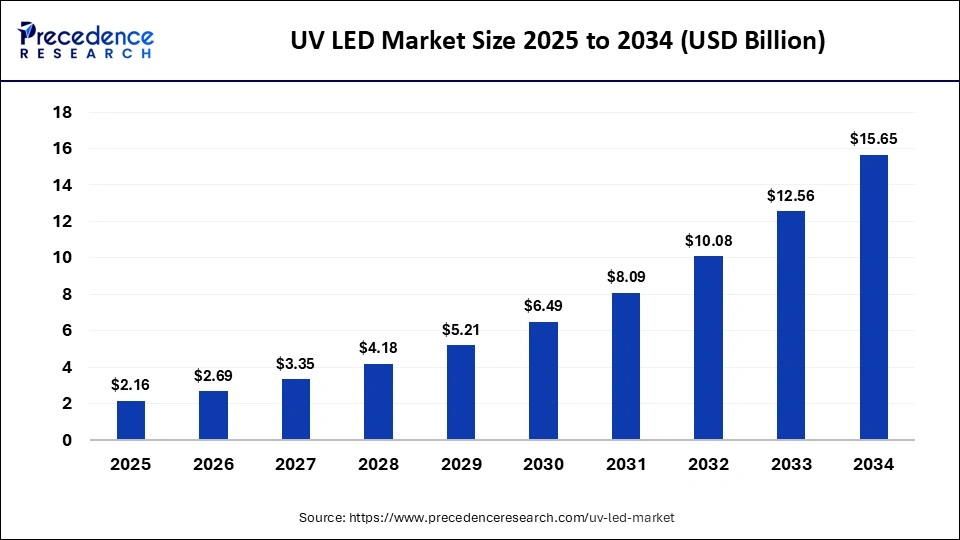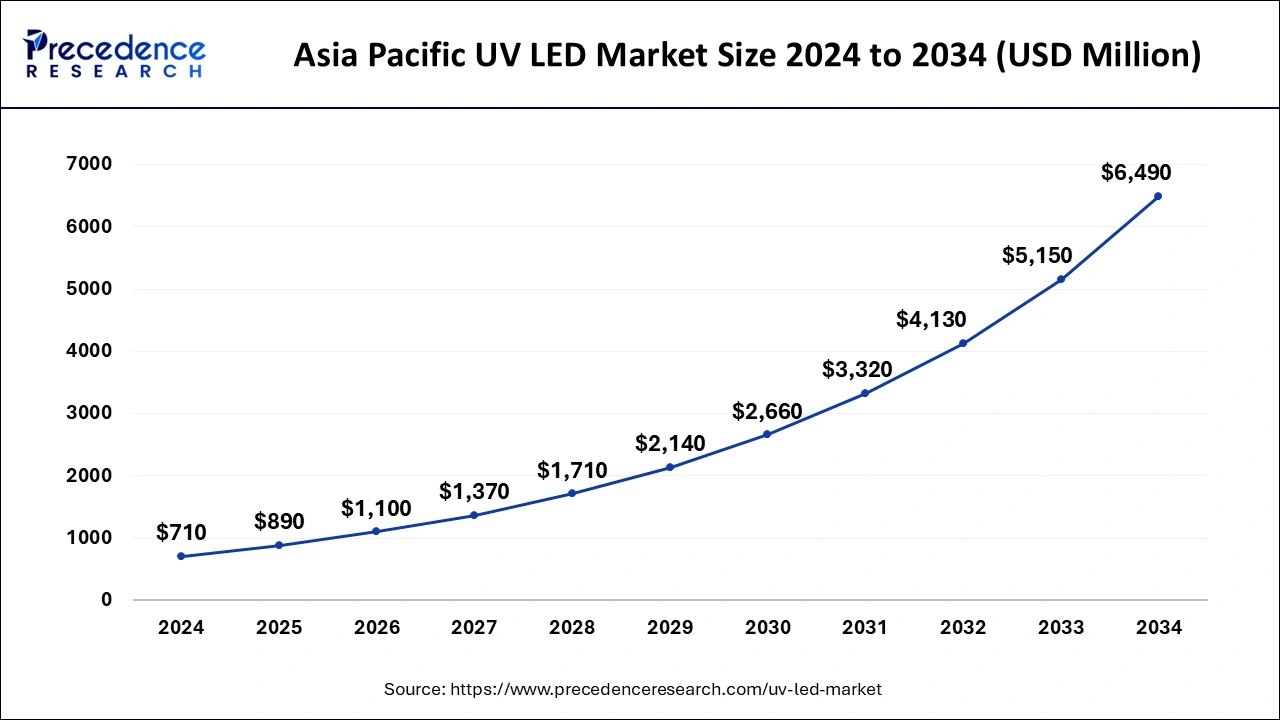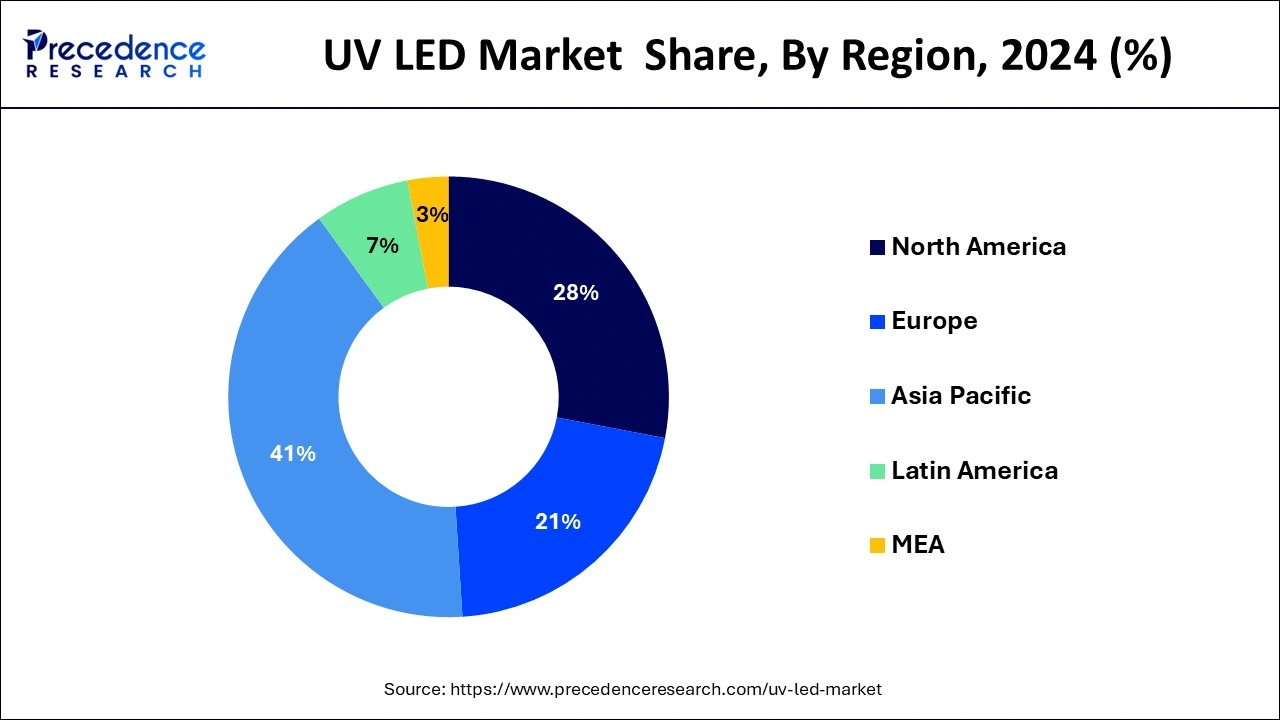The global UV LED market size is valued at USD 2.16 billion in 2025 and is forecasted to reach around USD 15.65 billion by 2034, accelerating at a CAGR of 24.62% from 2025 to 2034. The Asia Pacific UV LED market size surpassed USD 890 million in 2025 and is expanding at a CAGR of 24.77% during the forecast period. The market sizing and forecasts are revenue-based (USD Million/Billion), with 2024 as the base year.
The global UV LED market size surpassed USD 1.73 billion in 2024 and is estimated to hit around USD 15.65 billion by 2034 with a CAGR of 24.62% from 2025 to 2034. The increasing use of UV LEDs in the healthcare and automobile industries and the rising advancements in LED technology contribute to the growth of the UV LED market.

AI helps in the development of UV LED products. By utilizing AI algorithms, researchers can explore new materials and designs that enhance the effectiveness of UV LEDs. AI technology plays a crucial role in enhancing the effectiveness of UV-C sanitization, particularly for high-risk surfaces that are more susceptible to contamination. This process begins with the intelligent identification of specific surfaces that require sanitization, utilizing advanced algorithms and machine learning techniques to assess and prioritize these areas based on risk factors. Once the target surfaces are determined, a high-performance UV LED beam is deployed to deliver precise and powerful ultraviolet light, effectively eliminating pathogens and ensuring a thorough sanitization process. This innovative approach not only increases the efficiency of cleaning protocols but also assures a safer environment by focusing on the most vulnerable zones. Moreover, AI algorithms are used to optimize manufacturing processes, increase production efficiency, and improve the quality of UV LEDs.
The Asia Pacific UV LED market size was evaluated at USD 710 million in 2024 and is predicted to be worth around USD 6490 million by 2034, rising at a CAGR of 24.77% from 2025 to 2034.

Asia Pacific dominated the UV LED market in 2024. UV-C LEDs are challenging to manufacture technologically and are expected to be launched by many leading vendors in the region, which will have a notable impact on the UV LED market growth. Considerable investments by several vendors based in China and Japan are making notable changes in the market, further expanding the market growth globally with various UV LED light applications.
In the end-user industries of package printing, ultraviolet LEDs are widely used for printing on materials like aluminum foil, paper, and plastic shits. Printing made on the packaging of wine and cigarettes is an example of the application of the UV LED ink printing method. Applications of UV LEDs are further expanding in the automobile sector; they can be used for painting a car or vehicle.

Japan is another massive hub for technological innovations as it is approaching research and developments for UV-based adhesive products. Recently, UV-based adhesives have become more applicable in the packaging, electrical, and automotive markets. Several manufacturers in Japan are more interested in developing and using a UV LED application in markets such as sterilization and disinfectant products market to expand their portfolio. Compared with Japan and China, South Korea has a low consumption level of UV LED-based applications; they are still in the initial phase of development of UV LED and its applications.
North America is witnessing notable growth in the UV LED market owing to the significant use of UV LED applications in various industries, including skin treatments. Printing industries in North America have UV LED curing systems, leading to exponential market growth in the United States. Also, demand for air and water purifiers in the United States is notably higher than in the past, which is responsible for the market growth. Energy efficient lighting, ease of use, and a wide range of applications in the disinfection process are the significant reasons that are driving the UV LED market in North America.
The UV LED market offers an electronic device that works on a technology that converts electrical energy into ultraviolet light. The UV LEDs can generate light when current flows through the terminals. The temperature with which these lights operate is less than 100 degrees. Such LEDs are used in electronic devices because they expose PCBs to the air. A diverse range of products in the UV LED market have found application in various fields, such as forensics, disinfection, sterilization, purification, medical phototherapy, etc.
Increasing government policies for saving energy and broadening the area of applications with numerous technical advancements in the use of UV LED are some of the major driving factors of the UV LED market. Nearly all industries use UV LED technology due to the benefits such as low power consumption, continuous UV output with high-cost saving, and less energy dissipation, leading to safe operations. Earlier, UV LED was used in restricted areas. Still, today, due to continued research and developments, this technology has pervaded several industries, such as the manufacturing of beauty and health products, including wine, spirits, and beer.
UV LED technology helps build flat panel displays used in televisions and cell phones. Result in a higher adoption rate of UV LED by many sectors; thus, technology is expected to witness ascending growth in the foreseen period.
| Report Coverage | Details |
| Growth Rate from 2025 to 2034 | CAGR of 24.62% |
| Global Market Size in 2025 | USD 2.16 Billion |
| Global Market Size by 2034 | USD 15.65 Billion |
| Largest Market | Asia Pacific |
| Base Year | 2024 |
| Forecast Period | 2025 to 2034 |
| Segments Covered | By Technology, By Application, and By End Use |
| Regions Covered | North America, Europe, Asia-Pacific, Latin America, and Middle East & Africa |
Energy efficiency
UV LED light gives an energy-efficient output that saves dissipated energy that might be wasted otherwise. It is more cost-effective than conventional lights due to no requirement for preheating, and it is primarily compact in size, which in turn reduces its maintenance. It provides evenly distributed heat with fast heating, which gives concentrated light energy, and hence, it consumes substantially less power to operate. UV LED can be easily turned on and off, unlike other lamps with mercury in them. Due to such flexibility, UV LEDs are user-friendly for various applications that do not adversely affect the environments around them by dissipating unnecessary heat or toxic output as a byproduct. Hence, these reasons drive the UV LED market on a global level.
Restraint
Conventional methods to disinfect the products incorporate chlorine. Although chlorine is toxic in nature and has adverse effects on the environment, it is still widely used for disinfection. The chlorination system requires one tank for solution, a feeding pump, and a holding tank. That is why the chlorination method for disinfection is relatively cheaper than the UV light disinfection method. It is 10 to 15% lower in cost than the UV light method for disinfection. Also, the chlorination system is easy to install and less expensive in terms of maintenance. Hence, they are preferably used for small-scale applications like water tanks for residences. Due to its lower cost and ease of use, chlorination is convenient for people with a smaller budget. This can be a challenging hurdle that needs to be overcome in the growth of the UV LED market on a global level.
Incorporation of UV LEDs in the automotive sector
The automotive industry is a prominently growing sector, and it's expected to witness a higher growth rate owing to the integration of new technologies with the automotive industry, such as UV LED applications, which have made its presence strong in the automotive market. Many companies are using UV LEDs to create automotive parts such as wheels, bumpers, and door handles and to coat them. UV LED reduces time consumption in the curing process. It can also be used for curing adhesives used in automotive manufacturing that enhance the quality of the bond. Besides curing coatings, UV LEDs are also used for interior and exterior automobile lighting options.
UV LED lightning technology offers several benefits over the conventional method of lightning. It reduces energy consumption and offers high durability with longer life. UV LEDs can also be applicable for automobile safety purposes, such as detecting defective mechanical parts and components to avoid accidents. Also, disinfection can be done in the interior of automobiles by using UV LEDs that can prevent any infection that can potentially harm and spread by germs or other microorganisms.
The UV-C segment held the largest share of the UV LED market in 2024. The ultraviolet wavelength ranges from 100 to 280nm, which helps in low dissipating energy with a focused output of light energy. Thus, UV-C LED is expected to remarkably dominate the UV LED market and grow at the highest rate. This growth is due to increased demand for environment-friendly disinfection solutions and efficient output use. Emphasis on hygiene maintenance is a global concern, specifically in the hospitals, healthcare sectors, and public sectors, and has increased the demand for UV-C LED-based solutions. These LEDs offer many benefits, such as disinfection time being less relatively than other methods of disinfection, low use of chemicals, and reduced harmful byproducts.
Moreover, recent technological advancements have made UV-C LED efficiency relatively higher by increasing its operating time and affordability, which allows many sectors to incorporate them for various purposes. Manufacturers are investing in the research and development of UV-C LEDs to make them more affordable so that they can pervade every possible market.
Due to such high involvement in the development of UV-C LED, they are expected to witness substantial growth with more significant and broader opportunities for manufacturers of UV-C LEDs, including suppliers of components and system integrators. The rapid growth of the UV LED market, along with the increasing awareness of the need for hygiene maintenance, is spurring the UV-C LED segment in the global market. Therefore, it will be the leading segment of the UV LED market in the forecast period.
The disinfection segment is expected to experience substantial growth over the upcoming period. It is projected to grow at the highest CAGR rate. Attributes of this disinfection segment are several, such as increasing demand to keep hygiene properly in the healthcare field as it is more susceptible to spread numerous diseases due to the unhygienic conditions out there and thus, even a healthy person can be prone to infection if they have continuously stayed in such an unhygienic environment.
A firm solution is required as it is a problem faced by every country. Here, LED-based disinfectant solutions are more reliable as they are concentrated in form and are proven methods to seize the rapid multiplication of hazardous viruses and bacteria that could turn out to be disastrous, like COVID-19.
UV LEDs are able to kill many pathogens such as fungi, viruses, bacteria, and other mutant sources of disease and possible vectors that can spread a virus or bacteria. Their ability to quickly disinfect surfaces, water, and air made them more efficient for use in industrial areas. Thus, this is a major driving factor of the UV LED market, with the disinfection segment dominating.
Moreover, manufacturers are interested in investing in research and development of UV LEDs to increase their performance so that they can be widely available and applicable for several uses. Such relentless efforts by marketers are making UV LEDs more accessible for several types of disinfection applications.
The residential segment will witness rapid growth in the UV LED market owing to the higher demand by consumers. There is an increasing demand for clean and pure air sanitization and ventilation in residential spaces, which is necessary to achieve this. But in urban cities, due to the compact areas for living, ventilation cannot be achievable at every corner because of the increasing population in the same spaces. Hence, UV LEDs are a great choice to achieve this by emphasizing air purity with sanitization. UV LEDs can effectively inactivate viruses and bacteria, including different microorganisms, which lowers the risk of life-threatening health concerns that could be spread by polluted air.
Owing to the surge of technically advanced UV LEDs, accessibility is frequent, and hence, it is used by many residential consumers to sanitize the area they are living in. UV LED-based cleaning products are now available in compact sizes and are thus easily portable. Hence, such ease of application is fuelling the UV LED market on a global level, with a residential segment of end users dominated on a large scale.
Segments Covered in the Report
By Technology
By Application
By End Use
By Geography
For inquiries regarding discounts, bulk purchases, or customization requests, please contact us at sales@precedenceresearch.com
No cookie-cutter, only authentic analysis – take the 1st step to become a Precedence Research client